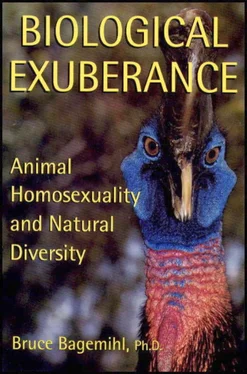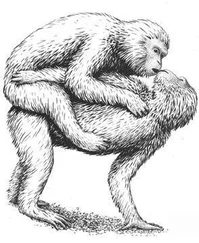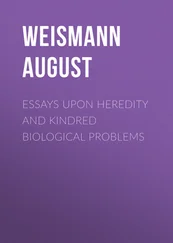39
Weinrich, Sexual Landscapes , p. 308.
40
Bonobo (de Waal 1997:107); Bottlenose Dolphin (Wells et al. 1987:294); Orang-utan (Galdikas 1981:285, 297, 1995:172; Kaplan and Rogers 1994:82).
41
Undoubtedly other species will be discovered that also exhibit this full range of characteristics. Many of these features are already known to characterize Stumptail Macaque sexuality, for example, including hidden estrous cycles (cf. de Waal 1989:150), anal and oral intercourse, and pairlike “sexual friendships” or “preferred partners” (and much remains to be learned about this species in the wild). Similarly, Japanese Macaques have pair-bonded consortships, face-to-face sexual encounters, and “social class” differences in sexual/pairing activity (cf. Corradino 1990:360), while Gorillas have face-to-face copulation, bonding or “preferred partners,” hidden estrous cycles (cf. Wolfe 1991:125), and oral sexual activities. Certain of these characteristics also occur individually in animal groups other than primates and cetaceans: a face-to-face mating position, for instance, is occasionally used by snow leopards, while Ruffs have a highly structured “class” system among males involving (among other features) differing sexual behaviors (Freeman, H. [1983] “Behavior in Adult Pairs of Captive Snow Leopards [ Panthera uncia ],” Zoo Biology 2:1-22). Another erroneous claim about human uniqueness is that no animal exhibits a type of homosexuality sometimes known as “(mutual) androphilia,” an interaction involving two adult males neither of whom adopts a stereotypically “feminine” gender presentation or sexual behavior (on the supposed absence of this in animals, see Houser, W. [1990] “Animal Homosexuality,” in W. R. Dynes, ed., Encyclopedia of Homosexuality , vol. 1, pp. 60-63 [New York and London: Garland]). In fact, exactly this sort of homosexuality occurs in Greylag Goose and Mallard Duck male pairs, as well as in a number of other species; see chapter 4 for further discussion of gender roles (or their absence) in homosexual interactions.
42
Weinrich, Sexual Landscapes , p. 305 (where this idea is formulated as the “technique puzzle” and characterized as “a disturbing generalization”); Masters, W.H., and V.E. Johnson (1979) Homosexuality in Perspective (Boston: Little, Brown).
43
Likewise, the durations of homosexual as opposed to heterosexual acts (such as mounting) are usually comparable. In some species, however, homosexual interactions generally last longer (e.g., Gorillas, White-handed Gibbons, American Bison, West Indian Manatees), while in others heterosexual encounters typically last longer (e.g., Harbor Seals, Red Foxes, Humboldt Penguins, Long-tailed Hermit Hummingbirds). In many species homosexual interactions do exhibit greater variability or flexibility in terms of the role differentiation of partners (see chapter 4 for further discussion).
44
Bonobo (Kitamura 1989:53—57, 61; Kano 1992:187); Gorilla (Fischer and Nadler 1978:660—61; Yamagiwa 1987a:12—14, 1987b:37; Harcourt and Stewart 1978:611—12); Hanuman Langur (Weber and Vogel 1970:76; Srivastava et al. 1991:496-97).
45
Japanese Macaque (Hanby and Brown 1974:164; Hanby 1974:838-40).
46
Flamingo (C. E. King, personal communication).
47
The head-to-tail position does occur in interspecies homosexual interactions with Tucuxi Dolphins. Same-species versus cross-species differences in mounting position (independent of the sex of the partner) are also found in other cetaceans. Among Bottlenose Dolphins, for example, a belly-to-belly mating position is typical of same-species contacts, both homosexual and heterosexual (cf. McBride and Hebb 1948:115, among others), while a sideways, dorsoventral position occurs in interspecies encounters with Atlantic Spotted Dolphins of both sexes (Herzing and Johnson 1997:92, 96).
48
Anderson, S. (1993) “Stitchbirds Copulate Front to Front,” Notornis 40:14; Tyrrell, E. Q. (1990) Hummingbirds of the Caribbean , pp. 114, 155 (New York: Crown Publishers); “Red-capped Plover, Charadrius ruficapillus ,” in S. Marchant and P. J. Higgins, eds. (1993) Handbook of Australian, New Zealand, and Antarctic Birds , vol. 2, pp. 836-47 (Melbourne: Oxford University Press); Wilkinson, R., and T. R. Birkhead (1995) “Copulation Behavior in the Vasa Parrots Coracopsis vasa and C. nigra ,” Ibis 137:117—19; Kilham, L. (1983) Life History Studies of Woodpeckers of Eastern North America , pp. 49—50, 143, 160 (Cambridge, Mass.: Nuttall Ornithological Club); Southern, W. E. (1960) “Copulatory Behavior of the Red-headed Woodpecker,” Auk 77:218-19.
49
Vasey, “Homosexual Behavior in Primates,” p. 195.
50
For further details see the primate profiles in part 2, as well as the discussion of nonreproductive heterosexualities in chapter 5.
51
For discussion of cultural traditions in animals, including references to many specific cases, see Bonner, J. T. (1980) The Evolution of Culture in Animals (Princeton, N.J.: Princeton University Press); Galef, B. G., Jr. (1995) “Why Behavior Patterns That Animals Learn Socially Are Locally Adaptive,” Animal Behavior 49:1325—34; Lefebvre, L. (1995) “The Opening of Milk Bottles by Birds: Evidence for Accelerating Learning Rates, but Against the Wave-of-Advance Model of Cultural Transmission,” Behavioral Processes 34:43-54; Menzel, E.W., Jr., ed. (1973) Precultural Primate Behavior (Symposia of the Fourth International Congress of Primatology, vol. 1) (Basel: S. Karger); Gould, J. L., and C. G. Gould (1994) The Animal Mind (New York: Scientific American Library). For an excellent survey of animal cultural traditions, see Mundinger, P. C. (1980) “Animal Cultures and a General Theory of Cultural Evolution,” Ethology and Sociobiology 1:183-223.
52
Japanese Macaque (Itani 1959; Gouzoules and Goy 1983:47; Eaton 1978; Wolfe 1984:152); Stumptail Macaque (Chevalier-Skolnikoff 1976:512; Bertrand 1969:193-94); Savanna Baboon (Ransom 1981:139). In Hanuman Langurs, mounting between females may also have a cultural component, since it exhibits wide variability not only between individuals but also between geographic areas. It occurs frequently in some regions (e.g., Jodhpur, India), less frequently in others (e.g., Abu and Sariska in India), rarely in others (e.g., Sri Lanka), and not at all in still others (e.g., some parts of Nepal) (Srivastava et al.1991:504—5 [table V]). Heterosexual courtship patterns in Common Chimpanzees also exhibit cultural variations (cf. Nishida 1997:394, among others).
53
Bonobo (Savage-Rumbaugh et al. 1977; Savage-Rumbaugh and Wilkerson 1978; Savage and Bakeman 1978; Roth 1995; S. Savage-Rumbaugh, personal communication). Drawings, verbal descriptions, and “glosses” of the hand signals and their meanings in the accompanying illustration are based on these sources. For alternate descriptions of some of these gestures, as well as gestures used in nonsexual situations, see de Waal 1988:214-21.
54
Bonobo (Savage-Rumbaugh and Wilkerson 1978:334; Roth 1995:75, 88).
55
Bonobo (Savage-Rumbaugh et al. 1977:108).
56
Linguists studying the structure of American Sign Language, for example, have identified a continuum of iconicity in signs, ranging from transparent signs (quasi-mimetic gestures whose meaning is readily identifiable from their form, even to nonsigners) to translucent signs (gestures in which a connection between meaning and form can be discerned but not automatically identified without knowing the meaning of the sign) to opaque signs (gestures in which all form-meaning correspondences have been lost). According to these criteria, the Bonobo gestures would fall primarily in the transparent-translucent range. For further discussion see Klima, E.S., and U. Bellugi (1979) The Signs of Language , especially chapter 1, “Iconicity in Signs and Signing” (Cambridge: Harvard University Press).
Читать дальше












